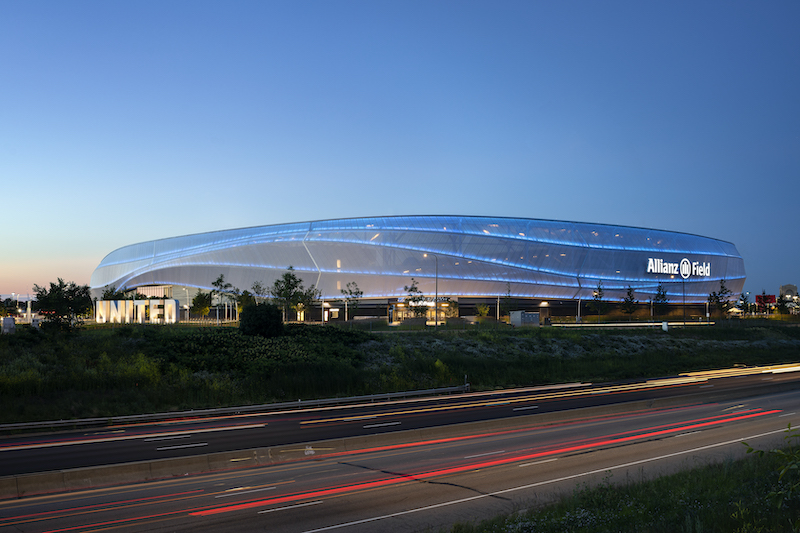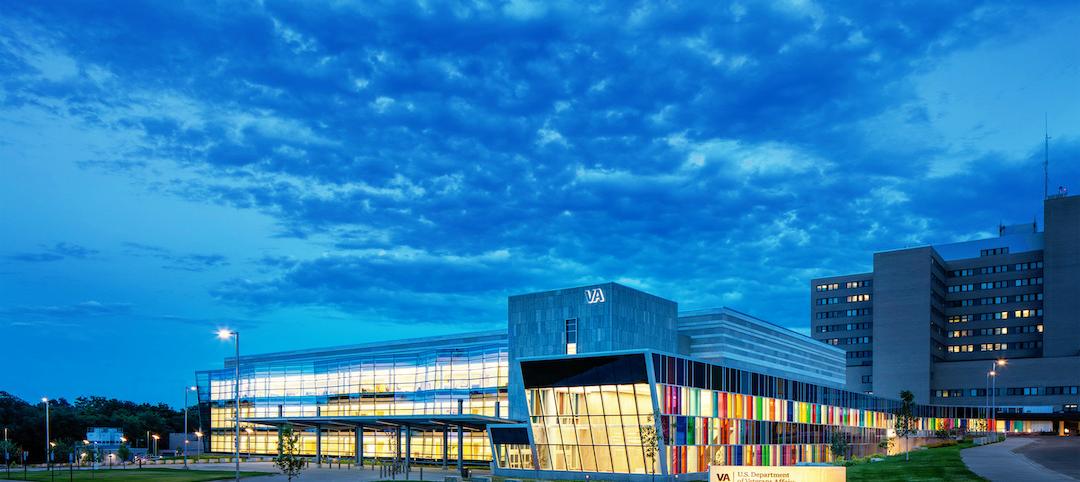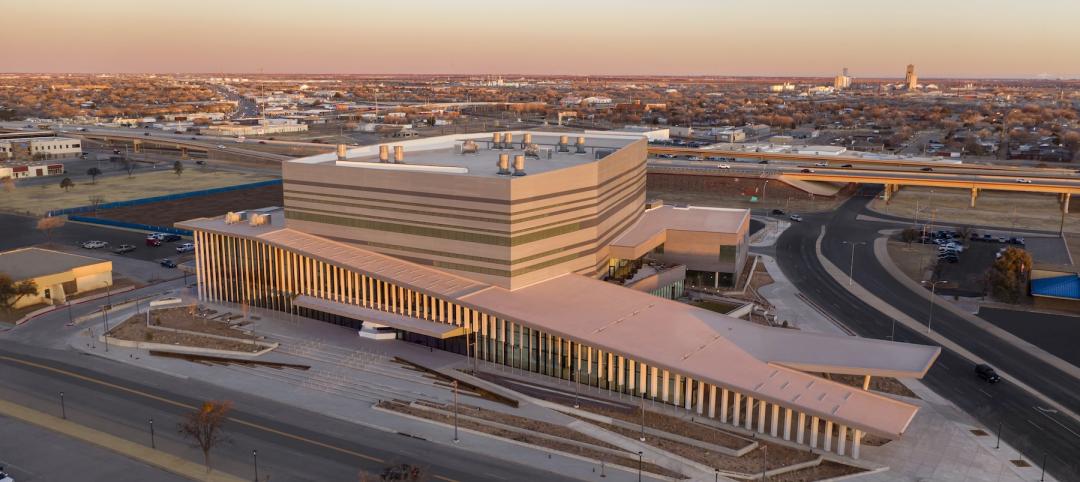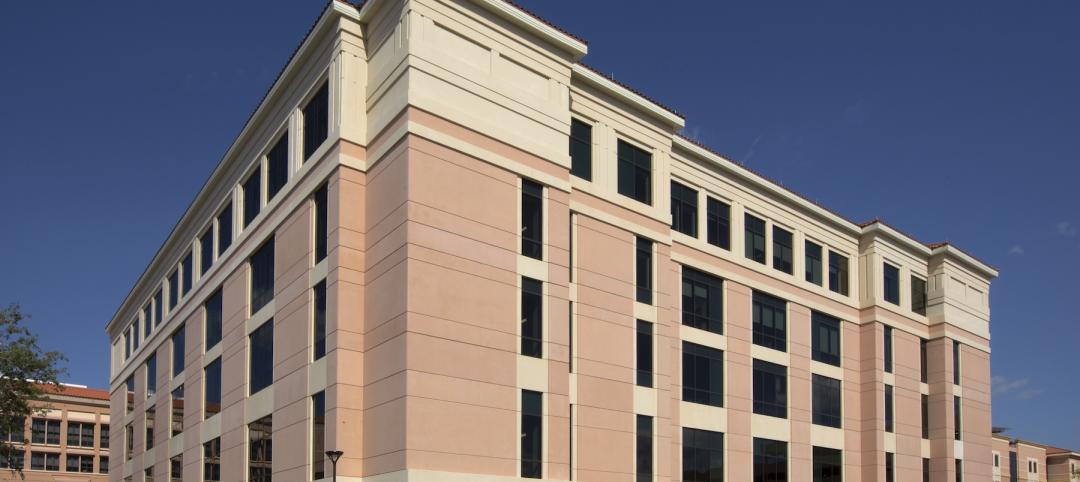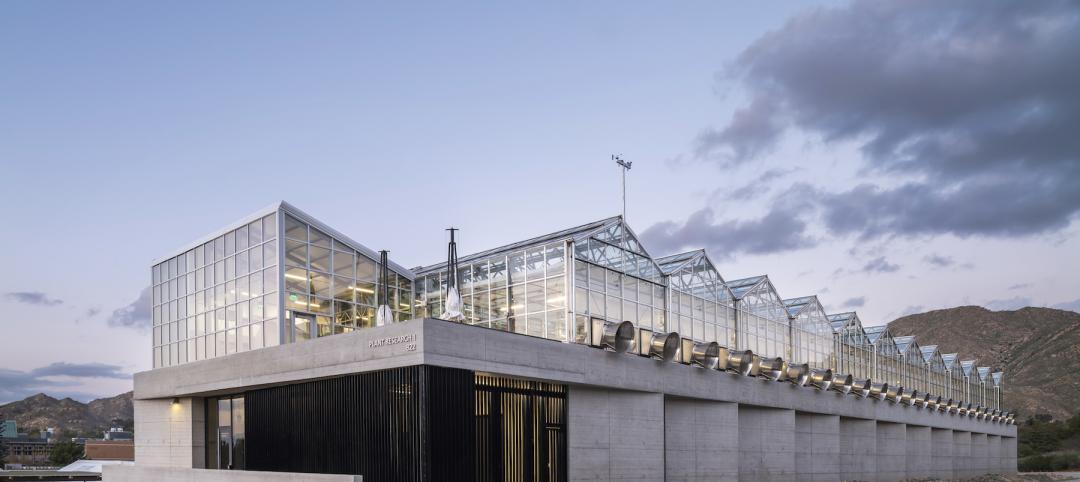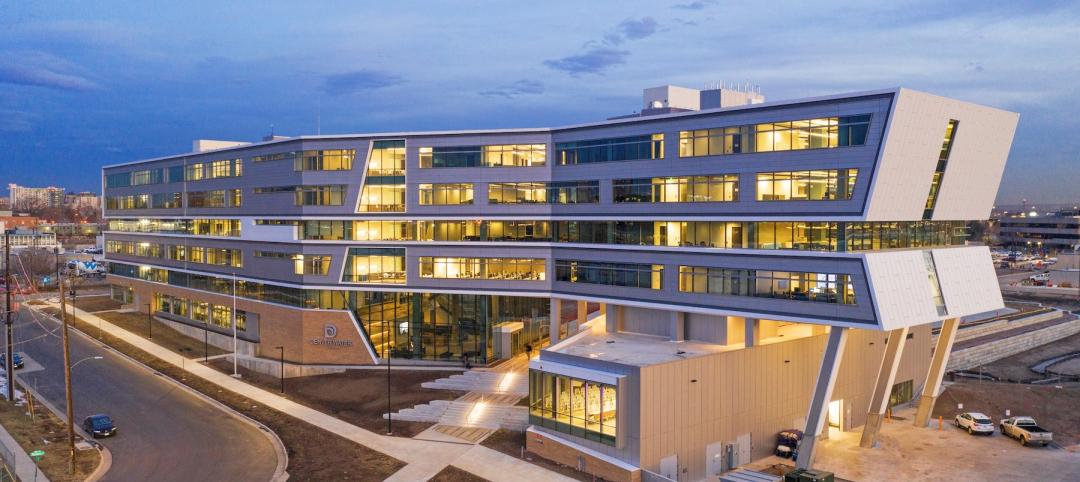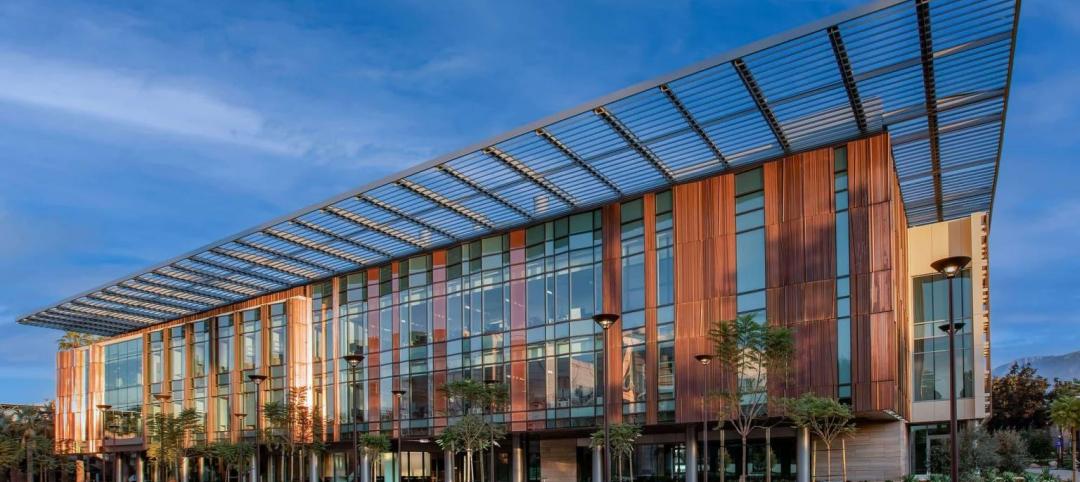Allianz Field, the new home of the Minnesota United, was designed to provide an intimate experience for fans, regardless of where they are in the stadium.
As such, the farthest seat in the stadium is only 125 feet from the pitch (which is elevated to add to the intimacy of the stadium, bringing fans even closer to the action) and a 2,930-capacity safe-standing supporters’ section features the steepest grade in MLS at 34.8 degrees, creating a “wall” of United fans and a unique home field advantage.
But Allianz Field isn’t just fan friendly on match days. In an effort to connect fans to the game year round, Allianz Field features amenities such as Brew Hall, a pub-like everyman’s club; the team store; the Great Lawn, a 28,000-sf green space for fans to gather on game days and non-game days alike; and a surrounding superblock of mixed-use development that is currently in development.
On the exterior, the stadium is wrapped in 88,000 sf of PTFE mesh wrap to create an exterior skin that is the first-of-its-kind in a professional sports venue, and can be illuminated in endless possibilities thanks to 1,700 LED lights. The use of the lightweight PTFE skin reduced the amount of steel required by an estimated 100 tons.
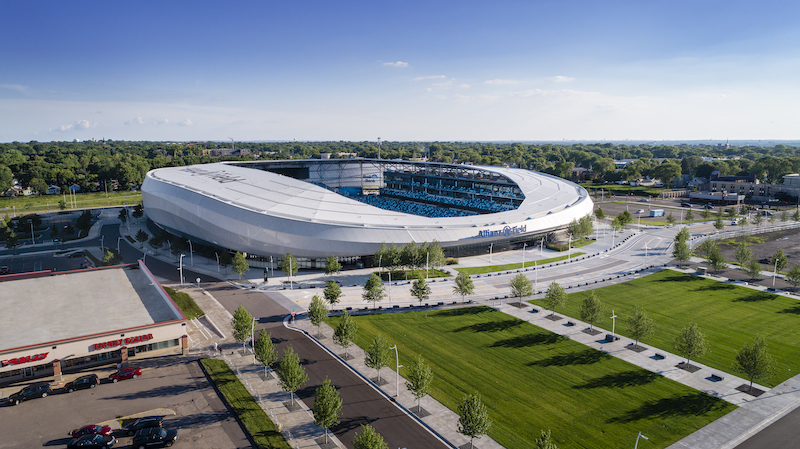 Photo: James Ewing.
Photo: James Ewing.
However, the fan-first design of Allianz Field didn’t come together without its challenges. For example, two acres of land occupied by a supermarket, bowling alley, and additional adjoining retail spaces needed to be acquired and demolished to make room for the stadium’s north. Originally scheduled for demolition in August of 2017, the date was pushed back to November to accommodate tenant lease agreements. This delay meant the construction team needed to re-sequence the project and extend work hours.
Work on concrete, mechanical, and electrical had to be accomplished in 10-hour, six-day weeks from July to November in order to get the project back on track for an early 2019 completion date. As the shopping mall was being cleared, steel crews built the stadium out along the interstate in a U-shape to start, rather than the traditional method of building in a circular formation. Prefabricated building components and systems, such as metal tresses that sit below the stadium’s canopy, helped to speed up construction, as well.
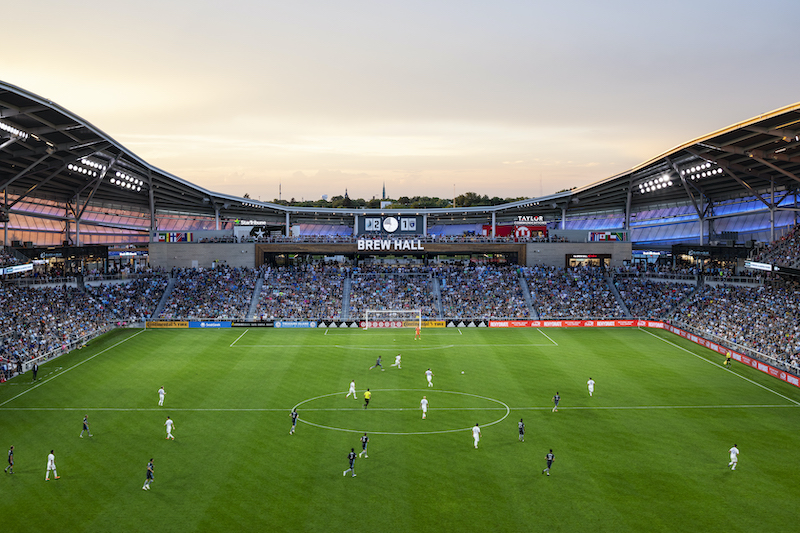 Photo: James Ewing.
Photo: James Ewing.
Further adding to the scheduled challenges were cold temperatures and high winds, which caused the job site to be shut down for several days in 2018. But the cold wasn’t the only weather-related issue. Over the course of a rainy two-month period, the project team had to filter and pump 1.2 million gallons of water off the job site. In order to overcome the scheduling issues posed by the weather, the team used the Last Planner System. The process was used to ensure that each subcontractor on site could manage their workload while also holding them responsible for the work they promised to complete. The Last Planner System proved effective as the team made up for the lost time, completing the project both on schedule and budget.
High winds were a key consideration when determining the best method of building the stadium. A stadium model with sensors and grid lines was put into a wind tunnel to assist with the design and engineering. Based on the resulting data, the build team placed 330 rock anchors 65 feet underground (no easy task considering the frozen ground and the use of water-based grout in sub-freezing temperatures) to protect the PTFE and slab-on-grade elements from wind loads.
With so many challenges threatening the project’s scheduling, the team conducted bi-weekly autonomous drone flights using 3DR Site Scan to more efficiently manage the site. The drone images were used to pull dimensions, calculate material volumes, manage on-site equipment, and determine material laydown areas. The images were also used to communicate with neighbors and adjacent businesses, which aided in minimizing disruptions. The information was shared through a cloud-based project management system that could be accessed anywhere. This kept the entire team informed in real-time.
 Photo: Alise O'brien.
Photo: Alise O'brien.
The project also employed the use of virtual MEP coordination for significant labor cost savings. By accurately coordinating the MEP systems prior to construction, the MEP trades were able to use GPS to lay out and install hanger inserts into the concrete deck framework before the concrete deck was poured. This eliminated the need for hundreds (possibly thousands) of threaded rods that would otherwise have been hand-drilled into the concrete from below to support piping, ductwork, and conduit.
The building team’s efforts not only allowed Allianz Field to achieve its goal of creating a fan-first experience, but the stadium also achieved high marks in energy efficiency, rainwater capture, bird safety, and reduced and recycled steel use.
Submitting firm, Architect of Record, Interior Architect: Populous
Owner: Minnesota United FC
Owner’s rep: Tegra Group
MEP Engineer: ME Engineers
Structural Engineer: Walter P. Moore & Associates
Civil Engineer: Loucks, Inc.
Construction Manager: Mortenson Construction
Size: 346,000 sf, 19,600 seats
Construction time: November 2017 to February 2019
Cost: NA
Delivery method: CM at Risk
Photo credit: Alise O’Brien, James Ewing
Related Stories
| Aug 29, 2022
Montana becomes first U.S. state to approve 3D printing in construction
Montana is the first U.S. state to give broad regulatory approval for 3D printing in building construction.
Architects | Apr 22, 2022
Top 10 green building projects for 2022
The American Institute of Architects' Committee on the Environment (COTE) has announced its COTE Top Ten Awards for significant achievements in advancing climate action.
Concrete Technology | Apr 19, 2022
SGH’s Applied Science & Research Center achieves ISO 17025 accreditation for concrete testing procedures
Simpson Gumpertz & Heger’s (SGH) Applied Science & Research Center recently received ISO/IEC17025 accreditation from the American Association for Laboratory Accreditation (A2LA) for several concrete testing methods.
2021 Building Team Awards | Jan 14, 2022
First public-private partnership project in Veterans Administration history saves $34 million in costs
LEO A DALY and McCarthy Building Companies head the project team for the Omaha VA Ambulatory Care Center in BD+C’s 2021 Building Team Awards.
Building Team Awards | Dec 8, 2021
A performing arts center celebrates a legendary rocker and his birthplace
Buddy Holly Hall in Texas receives BD+C’s Silver Building Team Award.
Building Team Awards | Dec 7, 2021
A rapid response to a health emergency
Baptist Hospital of Miami’s 233-bed Hope Tower receives BD+C’s Bronze Building Team Award
Building Team Awards | Dec 3, 2021
Putting science on display, thanks to a design-build approach
UC Riverside’s Plant Growth Environments Facility receives BD+C’s Bronze Building Team Award.
Building Team Awards | Dec 2, 2021
An academic ‘precinct’ brings arts and sciences together
Wofford College’s Chandler Center for Environmental Studies receives BD+C’s Silver Building Team Award.
Building Team Awards | Dec 1, 2021
Denver sets the bar for water reclamation and reuse
A new administration building for the city’s water utility company scores Platinum in BD+C’s 2021 Building Team Awards.
2021 Building Team Awards | Nov 17, 2021
Caltech's new neuroscience building unites scientists, engineers to master the human brain
The Tianqiao and Chrissy Chen Institute for Neuroscience at the California Institute of Technology in Pasadena wins a Gold Award in BD+C's 2021 Building Team Awards.


